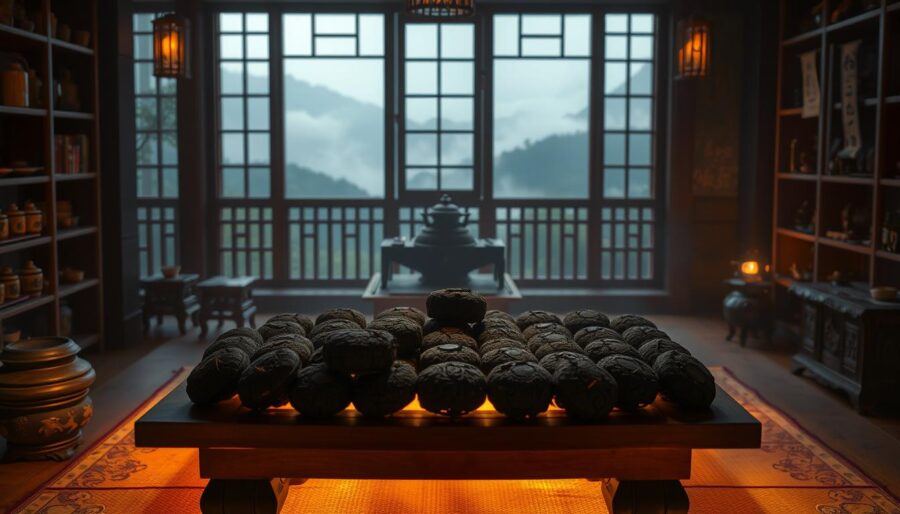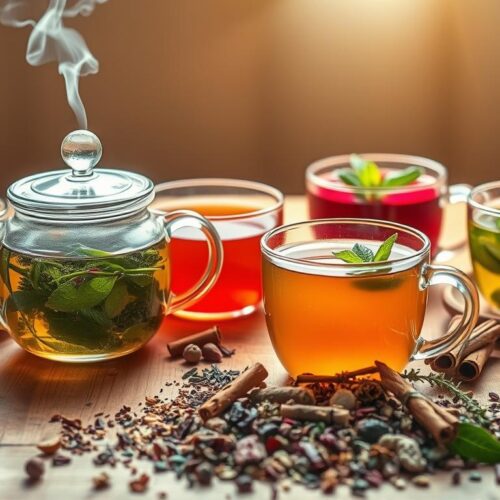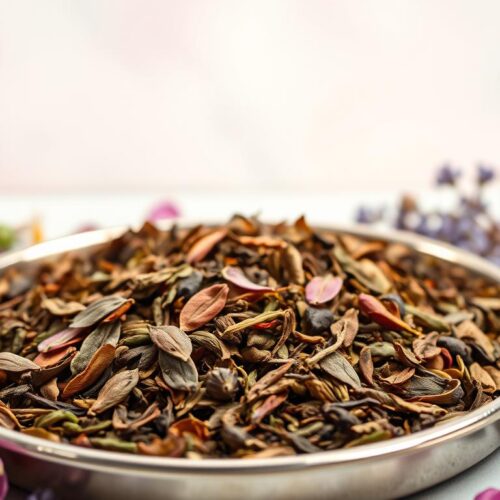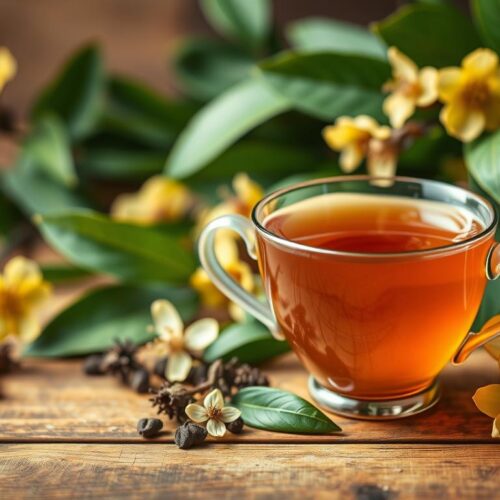Pu-erh tea’s story starts in China’s Yunnan. It comes from forests of Camellia sinensis var. assamica. After shaping fresh leaves, molds and bacteria kickstart its fermentation. This process is different from other teas. It influences the tea’s taste, texture, and aroma as it ages.
The tea is named after the Pu’er market town, a historical trade center. Nearby, Jingmai Mountain is honored for its Old Tea Forests by UNESCO in 2023. The Bulang and Dai communities have kept their tea culture alive. Their heritage influences the tea, perfect for focus or digestion.
There are two main types of Pu-erh tea. Sheng pu-erh, or “raw,” ages naturally and changes over time. Shou pu-erh, or “ripe,” is fast-aged through a special wet-piling process. Both types are crafted with care and offer unique benefits, like smoothness and energy.
Pu-erh tea ages gracefully, akin to fine wine. Aging affects its chemistry and taste. Shou pu-erh contains more gallic acid, whereas aged sheng pu-erh keeps its catechins. In the U.S., its popularity has risen, enjoyed in various forms. Each brew is a chance to dive into fermented tea’s world.
We’ll cover everything about pu-erh tea in this guide. Learn about sheng and shou pu-erh and how to use them. You’ll get tips on brewing, consuming, and buying. This way, you can fully enjoy the tea’s flavor, tradition, and benefits.
What is Pu-erh Tea?
Pu-erh tea comes from Yunnan and is named after Pu’er, a historic town. It used to be carried along mule paths to Tibet and Southeast Asia. The tea was loved for its strong flavor and long-lasting quality. Jingmai Mountain’s Bulang and Dai communities have grown tea for ages. In 2023, UNESCO celebrated these tea forests as a living heritage.
To make Pu-erh, leaves are first pan-fired, rolled, and then sun-dried. This initial form is called maocha. If left to ferment, with the help of microbes, it becomes sheng pu-erh. This traditional method uses molds, yeasts, and bacteria, like Aspergillus luchuensis. Aging changes the tea’s polyphenols and sugars, making its color deeper and its aroma richer.
In the 1950s, Hong Kong’s demand led to the invention of darker pu-erh. By 1973, Kunming Tea Factory came up with wòduī, a special way to pile the tea for fermentation, which Menghai Tea Factory also started using. This new method made shou pu-erh, which is smooth and can be drunk right away, similar to older pu-erh tea.
There are two types of pu-erh tea, sheng and shou, which can be loose or pressed into shapes. Only large-leaf tea from Yunnan is real pu-erh. The labels show the year and place of origin. This helps you know more about the tea and its aging process. Pu-erh, known as heicha in China, is different from the black tea known in America. It offers a unique journey of time, place, and craftsmanship.
Health Benefits of Pu-erh Tea
Pu-erh tea benefits span weight management, heart health, and aiding digestion. It’s a fermented tea, so it has unique compounds. These compounds shape how your body reacts to the tea.
For weight management, pu-erh tea gives you a caffeine boost and helpful molecules from fermentation. Ripe pu-erh has more gallic acid, useful for weight goals. And aged raw cakes keep catechins, aiding in fat breaking. It gives you steady energy, smoother than coffee.
When it comes to heart health, pu-erh tea shows promise. The tea’s changes in polyphenols might help with cholesterol. It’s not a cure-all, so keep eating well and staying active. Yet, pu-erh tea can be part of a heart-healthy lifestyle.
Many enjoy pu-erh tea for better digestion. It pairs well with heavy meals in Yunnan. The fermentation reduces bitterness, making it easier on the stomach. Plus, it’s a comforting choice for evenings.
| Focus Area | What You May Notice | Key Compounds Discussed | How to Try It |
|---|---|---|---|
| Weight Management | Smoother energy and support for active days | Caffeine, catechins, gallic acid from fermented tea | Start with 1–2 short infusions in the morning |
| Heart Health | Supportive routine alongside diet and exercise | Polyphenol shifts affecting lipid profiles | Brew daily at moderate strength; avoid excess sweeteners |
| Digestion | Comfort after meals and a softer mouthfeel | Acids and metabolites from fermentation | Enjoy a cup 20–30 minutes post-meal |
| Alertness | Gentle focus with less jitters than coffee for some | Caffeine balanced by the tea matrix | Use lower water temps and short steeps to fine-tune |
Buying from reputable sources like Teavana, Harney & Sons, and Yunnan Sourcing is key. Your choice of raw or ripe cake affects taste and benefits. It shapes your experience with this unique tea.
It’s important to listen to your body. Spread out your drinking through the day. Sip after meals if you’re sensitive, and stay hydrated. This helps pu-erh tea support digestion and your overall wellbeing.
Nutritional Profile of Pu-erh Tea
Pu-erh tea is a special blend that gets its richness from natural fermentation. This process gives it unique compounds like polyphenols, amino acids, and minerals. These ingredients are what make pu-erh tea healthful and tasty without needing sugar or extra calories.
Aged raw pu-erh tea keeps a lot of good antioxidants, such as EGCG and other catechins. These antioxidants stay stronger in raw pu-erh than in ripe ones. So, the tea tastes brisker and looks lighter, showing its rich content.
Ripe pu-erh tea changes during the fermentation process. It has more gallic acid and a little more caffeine, but fewer catechins. The work of specific microbes changes the tea’s polyphenols, creating a deep taste and smooth feel.
Recent studies have updated our understanding of certain microbes in ripe pu-erh tea. The main microbe does not produce harmful toxins, making this tea safe to enjoy every day. This proves you can safely enjoy the health benefits of pu-erh tea daily.
Pu-erh tea stands out from green, oolong, and black teas. Ripe pu-erh has more gallic acid and smoother tannins, while raw pu-erh keeps more antioxidants. This difference places pu-erh tea in its unique category among fermented teas.
| Attribute | Aged Raw Pu-erh | Ripe Pu-erh (Wet‑piled) | Typical Green Tea |
|---|---|---|---|
| Core Process | Sun‑dried maocha, slow natural aging | Microbial wet‑pile fermentation | Fixation, rolling, drying (no microbial step) |
| Catechins (EGCG‑rich) | Higher retention; brisk profile | Lower total due to fermentation | High; fresh, astringent edge |
| Gallic Acid | Moderate | Higher; contributes to smooth depth | Lower |
| Caffeine | Moderate | Moderate to moderately high | Moderate to high |
| Aroma/Body Signals | Herbal, camphor, lively tannins | Earthy, cocoa, round body | Grassy, floral, light body |
| Microbial Influence | Slow aging reshapes polyphenols | Aspergillus luchuensis drives conversion | None; enzymatic oxidation only |
| Notable Takeaway | Antioxidant‑forward with vivid finish | Metabolite‑rich with gentle tannins | Fresh catechin punch without fermentation |
Choosing between raw and ripe pu-erh means balancing catechins with gallic acid and caffeine. Either choice puts pu-erh tea in a league of its own among fermented teas. This lets you dive into the flavors and benefits unique to pu-erh tea.
How to Prepare Pu-erh Tea
Start with waking the tea leaves. If you have bingcha or tuocha, break off a small piece neatly. Rinse the pu-erh tea quickly with hot water to open the leaf and remove dust. Then, toss out that water.
Use boiling or almost boiling water for shou pu-erh. The first brew should be steeped for 10–20 seconds. As the leaves begin to open, you can steep them a bit longer. This tea type allows for many steeps, each with a rich earthy taste.
Sheng pu-erh needs cooler water, just hot and steaming. Start with very short steeps to maintain a lively, sharp flavor without bitterness. Increase steeping time gently as the leaves become softer and sweeter.
Pressed cakes of tea are created by steaming the leaves, then pressing them. This makes the flavor release slowly. This slow release is perfect for gongfu brewing, which needs short, frequent steeps and careful timing.
There are quick ways to enjoy pu-erh on busy days. Cold brewing lets you steep pu-erh in cold water for up to 24–48 hours. Places like Pu’er Taiwan Tea & Coffee show off its smooth taste with minimal bitterness. For a cold drink, make a strong brew and pour it over ice. Shou pu-erh tastes great with a bit of milk. Sheng pu-erh pairs well with lemon and spices like ginger, cinnamon, and cloves.
| Style | Water Temp | First Steep | Key Notes | Best For |
|---|---|---|---|---|
| Shou pu-erh (ripe) | Near boiling to boiling | 10–20 seconds | Earthy, smooth; multiple short infusions after a rinse | Milk-friendly cups, iced lattes, rich daily brews |
| Sheng pu-erh (raw) | Hot but not boiling | Flash infusions (5–10 seconds) | Brisk, aromatic; extend time as leaves open to manage bite | Gongfu sessions, citrus accents, light food pairings |
| Cold brew pu-erh tea | Cold water | 24–48 hours | Velvety, low bitterness; clean finish | On-the-go bottles, summer service, subtle sweetness |
| Compressed forms (bingcha/tuocha) | Matches style (shou/sheng) | Short steeps after rinse | Steamed and pressed leaves release flavor gradually | Multi-infusion brewing, tasting flights, careful timing |
The Ideal Serving Size of Pu-erh Tea
You can drink pu-erh tea every day with several small brews in one sitting. Start with 3–5 grams of tea leaves for every 6–8 ounces of water. For gongfu style, steep for 10–20 seconds, and for Western style, steep for 2–3 minutes. This helps control caffeine and keeps the tea smooth.
If caffeine makes you jittery, try having your tea only in the morning or early afternoon. Pu-erh’s smooth taste comes from fermentation, and it’s gentle for many. Plus, drinking it throughout the day can have benefits. After meals, a light pour can be easier than a large mug.
Be on the lookout for signs of too much caffeine like restlessness, a fast heartbeat, jitteriness, or trouble sleeping. Strong or long steeps increase caffeine and acidity. Try using less tea, shorter steep times, or cooler water. Cold brews or light sheng pu-erh can cut down on bitterness.
Timing is key. Stay away from drinking it late at night to avoid sleep issues. Combine snacks like sourdough or almonds with ripe pu-erh to be kind to your stomach. This way, you’ll still enjoy the benefits of pu-erh, especially for digestion after big meals.
| Brewing Style | Leaf Amount | Water Volume | Steep Time (First Infusion) | Best For | Notes on Caffeine and Comfort |
|---|---|---|---|---|---|
| Gongfu (Ripe/Shou) | 4–6 g | 100–120 ml | 10–15 sec | Short, repeated sips | Multiple light steeps spread caffeine across time; smooth body supports tea for digestion. |
| Gongfu (Raw/Sheng) | 3–5 g | 100–120 ml | 10–20 sec | Bright, nuanced flavor | Use cooler water if sensitive; shorter steeps help you enjoy pu-erh tea benefits without jitters. |
| Western Mug | 2–3 g | 240–300 ml | 2–3 min | Simple daily routine | Moderate caffeine per cup; ideal for one or two servings alongside meals for tea for digestion. |
| Cold Brew (Overnight) | 5–7 g | 500–700 ml | 8–12 hrs (fridge) | Low bitterness, refreshing | Smoother extraction reduces edge; a steady way to capture pu-erh tea benefits with minimal acidity. |
| Afternoon Light Session | 2–4 g | 150–250 ml | 20–40 sec | Post-lunch focus | Gentle lift without overdoing caffeine; useful when you want tea for digestion and calm energy. |
Flavor Profile of Pu-erh Tea
There are two main styles in the cup. Sheng pu-erh starts bright and green, with fresh hay and citrus hints. Over time, its taste smooths into honey, dried apricot, and a soft woodiness.
Shou pu-erh offers a different experience from the first taste. It’s smooth, dark, and mellow, thanks to wet piling. This process gives it a gentle sweetness, earthy and woody tones, a cocoa hint, and a silky texture that stays with you.
Pu-erh tea flavors include earthy, woody, fruity, sweet, nutty, creamy, and smoky. How tightly the tea is pressed affects its aging. Iron cakes age slowly, whereas looser cakes or maocha reveal their fruit and spice notes sooner.
The way you store your tea plays a big role too. Keeping it clean and dry maintains its clarity and freshness, while humidity enhances its earthy qualities. Over time, sheng pu-erh becomes deeper, and shou pu-erh becomes smoother and more velvety.
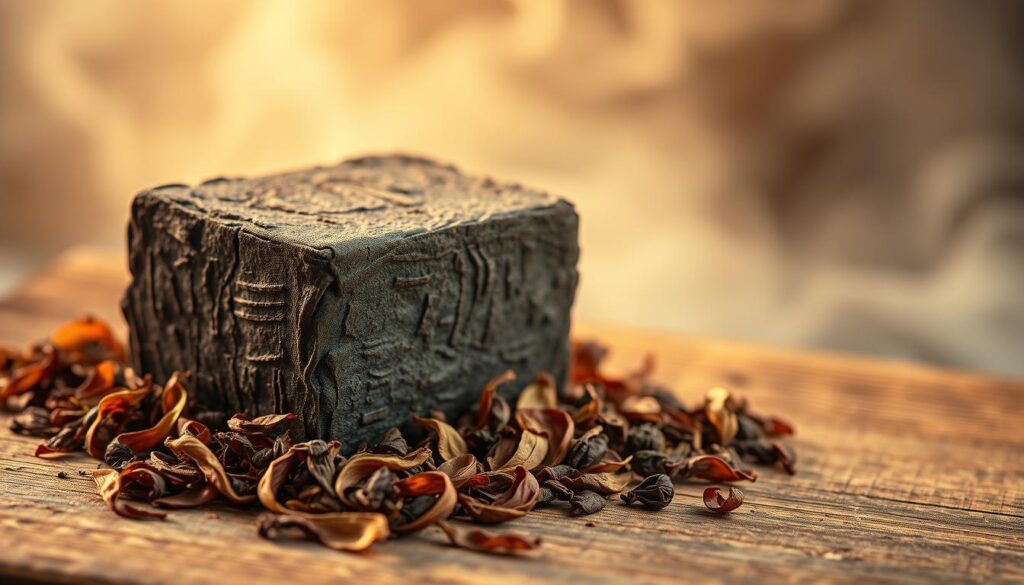
- It pairs well with rich foods: try it with braised beef, barbecue, mushrooms, or aged cheeses to highlight its earthy strength.
- If you prefer something fruity or sweet, match it with dark chocolate, almond biscotti, or dried figs for a perfect balance.
- For the cup: milk turns earthy teas creamy, perfect for a tea latte; lemon brightens sheng pu-erh when iced; and warming spices are great with shou pu-erh on chilly days.
| Style | First Impressions | Evolving Notes | Best Uses |
|---|---|---|---|
| Sheng pu-erh | Vegetal, brisk, light citrus | Honey, dried fruit, soft wood with pu-erh tea aging | Iced with lemon, pairing with lighter desserts |
| Shou pu-erh | Smooth, dark, gently sweet | Cocoa, damp wood, creamy body over time | With barbecue, mushrooms, aged cheeses, or a milk latte |
| Compression & Storage | Iron cake slows change; loose leaf opens early | Clean dry storage keeps clarity; humid storage deepens earth | Choose based on whether you want brightness now or deeper tones later |
Look at the liquor color and mouthfeel to judge quality. Clear amber in sheng signals clean aging. Deep mahogany and a smooth feel in shou suggest skilled fermentation and neat storage.
Your taste can guide how you brew it. Shorter infusions keep it lively, longer ones bring out deeper flavors like forest, leather, and cocoa. Track your tasting over time to discover how aging changes its aroma and taste.
Where to Buy Quality Pu-erh Tea
Start your search for quality pu-erh tea with trusted producers in Yunnan, like Kunming Tea Factory and Menghai Tea Factory (Dayi). They provide classic options that define the ripe and raw fermented tea styles. Their products come with detailed batch information and distinct factory marks, ensuring they are perfect for daily enjoyment and storage.
In the United States, specialty stores and cafés bring in genuine pu-erh tea with clear origins. Pu’er Taiwan Tea & Coffee stands out with its direct-import lines and even cold-brew variations, showing the distinct tastes across regions and ages. Over in the United Kingdom, Pu-erh Craft is known for its carefully chosen, high-quality selections supported by clear sourcing.
Follow a simple checklist when buying. Make sure it’s from Yunnan and made from large-leaf strains. Verify the production year, how it’s been stored, and whether it’s sheng (raw) or shou (ripe) fermented tea. Also, check its form—cakes, bricks, or tuocha—and look for the nèi fēi, which identifies the factory or artisan.
Trustworthy sellers provide details on the harvest area, how the tea was stored, and how it was handled. Stay away from products labeled as “black tea” in the Western way if you’re looking for authentic pu-erh tea. Real pu-erh is a dark, fermented tea with known fermentation processes and trackable batches. If unsure, request photos of the tea’s wrappers, seals, and batch numbers to ensure it’s from Yunnan.
Price often reflects quality, yet it’s essential to understand the context. Fresh sheng may taste a bit bitter but smells great, while aged shou is earthy and smooth. A fair price usually comes with a clear storage background, undamaged packaging, and trustworthy brands that collectors respect.
- Verify origin: Yunnan, large-leaf cultivar, and factory or artisan marks.
- Check type: sheng vs. shou, with storage details listed.
- Inspect form: cakes, bricks, or tuocha with a visible nèi fēi.
- Choose vendors known for transparent sourcing and clean storage.
- Avoid mislabeled “black” teas; seek documented pu-erh tea as dark, fermented tea.
Common Misconceptions About Pu-erh Tea
People often think all “black tea” is the same as fermented tea. But, most black teas are oxidized, not fermented. Pu-erh is a true fermented tea. This is why it smells and feels different and why many seek its unique benefits.
Some believe ripe pu-erh tea is “cooked.” However, “shou,” which means “ripened,” is a better term. The tea is fermented using wet piling by producers, not cooked with heat. This method enhances its texture and feel without boiling or pan-frying the leaves.
There are safety worries too. Some fear molds in pu-erh could be harmful. But, research found the main fermenting mold now identified as Aspergillus luchuensis, doesn’t carry risk genes. Choosing quality pu-erh from reputable sources like Yunnan Sourcing or the archives of Teavana ensures both taste and safety. Good storage also plays a key role.
Translation issues add confusion. In China, “dark tea” is heicha, while in the West, “black tea” usually means oxidized teas. Storage methods matter too: dry storage keeps the tea cleaner, wetter storage softens it quicker. New tea drinkers might not appreciate the earthy aroma at first, even though it’s a sign of quality to many.
Ripe and aged raw pu-erh teas have different profiles. Ripe teas tend to have more gallic acid and caffeine, giving them a cocoa-like body. Aged raw teas hold more catechins, offering a brighter, more resinous taste. Knowing the tea’s year, region, and type (sheng or shou) sets the right expectations and enhances your experience.
| Myth | Reality | What to Look For | Why It Matters |
|---|---|---|---|
| All “black tea” is fermented like pu-erh | Most black teas are oxidized; pu-erh is microbially fermented | Origin (Yunnan), leaf grade, and storage notes | Sets flavor and body expectations; clarifies fermented tea vs. oxidation |
| Ripe pu-erh is “cooked” | Shou is ripened via controlled wet piling, not cooking | Producer methods and batch details | Explains texture, sweetness, and consistent profiles |
| Pu-erh is unsafe due to molds | Key species is Aspergillus luchuensis, lacking ochratoxin genes | Clean aroma, reputable vendor, proper storage | Supports safe use while exploring pu-erh tea benefits |
| Earthy equals “bad” | Earthy notes reflect microbial aging and storage | Dry vs. wet storage descriptors on labels | Guides you to preferred profiles within fermented tea |
| Ripe and aged raw are interchangeable | Ripe skews to gallic acid and caffeine; aged raw to catechins | Type (sheng/shou), harvest year, region | Improves pairing, brewing, and daily selection |
Pu-erh Tea in Popular Culture
Pu-erh tea has moved from hidden corners to the spotlight in the U.S. Specialty cafés treat it as a fine wine, showcasing its origins, aging process, and storage. They share the story of its earthy uniqueness, calling it a “drinkable antique.” This attracts both collectors and those trying it for the first time.
On social media, you find short videos comparing sheng and shou teas. These videos show tea sessions that reveal color changes after many brews, and cold brew recipes that highlight its clear taste and sweetness. Through these posts, the benefits of pu-erh tea become real, sparking your interest to try brewing it yourself.
Cafés use their menus to teach about pu-erh tea. Pu’er Taiwan Tea & Coffee, for instance, offers a 48-hour cold brew. This brew challenges the idea that pu-erh is only earthy. It offers a fresh, clean taste, while still offering classic benefits like calm focus and a gentle boost in energy.
With the rise of online shopping, comparing tasting sets becomes easy, just like single-origin coffee. Brands put together collections by age and how they’re stored. This helps you explore from young sheng to aged shou. Pu-erh tea naturally fits into both your daily routine and weekend hobbies through this.
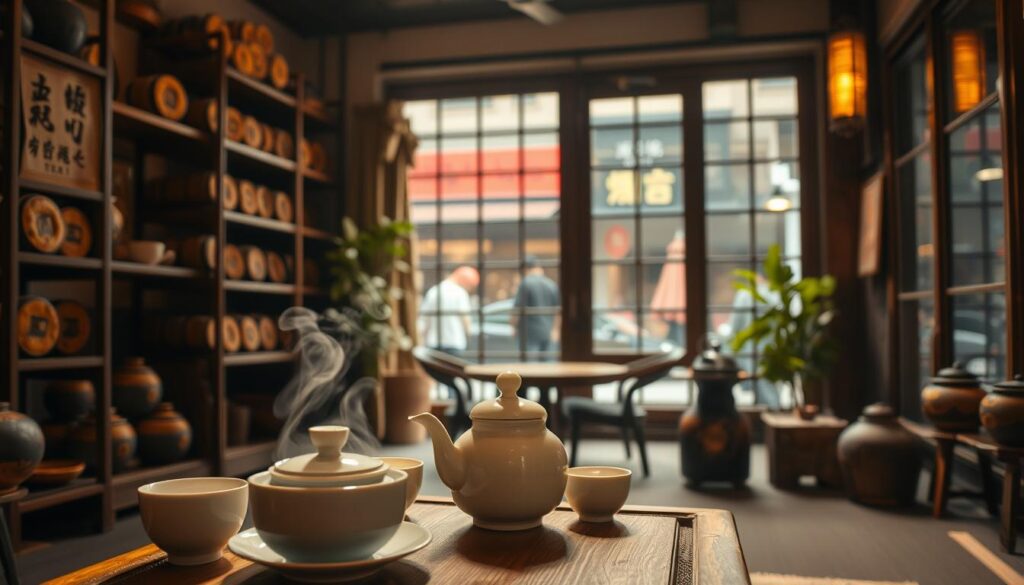
Influencers and tea experts shine a light on brewing tools, like gaiwans and clay pots. They show how small tweaks can change the tea’s scent and feel. You learn about leaf pressing, proper rinsing, and the best water temperature. This journey turns pu-erh into a common language that’s full of tradition and open to exploration.
Conclusion: Embracing Pu-erh Tea for Wellness
Adding pu-erh to your daily routine is easy. Enjoy it as a tea to aid digestion after eating. Or brew it in the morning for a smooth start. You can pick shou for its rich flavor right away or young sheng for a more lively taste. Just adjust the water’s heat and the steeping time to fit your liking. Remember, drinking it every day is mostly safe, but keep an eye on your caffeine levels.
The process of aging pu-erh tea changes its taste and feel. Explore its different forms like bing cakes, tuocha nests, and bricks. Take note of the production year and where it comes from to fully appreciate its unique flavor. Over time, how it’s stored and fermented shifts its scent from earthy to either floral or fruity. This gradual change is what makes pu-erh tea so special and beneficial.
Begin with brands known for quality to really get to know pu-erh tea. Places like Kunming Tea Factory and Menghai Tea Factory are known for their expertise in making tea that stands out. Visit cafés that get their tea directly from Yunnan and try sheng and shou together. This will help you see how the type of leaf, how it’s pressed, and its age changes the way it tastes.
You can also put a new spin on your pu-erh. Try making it cold for a refreshing drink in the afternoon. Or spice it up with lemon, milk, or warm spices depending on the time of year. Whether you like your tea light and fresh or rich and full-bodied, making it thoughtfully lets you enjoy all its benefits. As time goes by, you’ll discover your own favorite ways to enjoy pu-erh tea for better digestion, relaxation, and enjoyment of its changing flavors.

